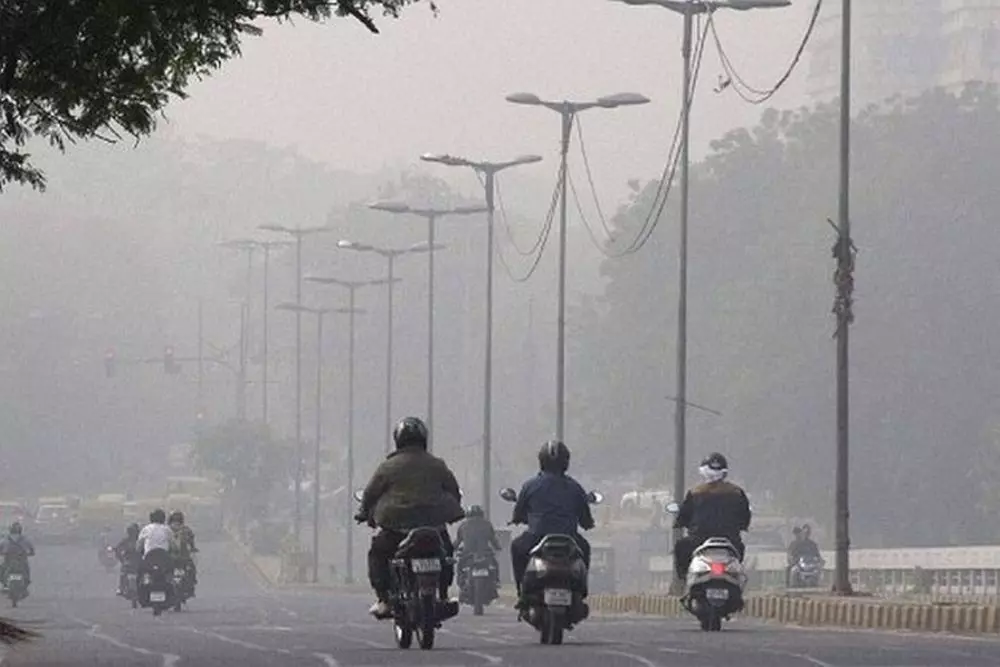Curb on non-essential construction, primary schools shut as air quality in Delhi worsens

New Delhi: Delhi-NCR’s air quality neared the emergency threshold on Thursday, prompting an immediate ban on non-essential construction work and the closure of primary schools in the Capital, as authorities acted swiftly to address the health-threatening pollution.
As a dense and pungent haze blanketed the skyline of Delhi-NCR, the concentration of PM2.5, fine particulate matter that can penetrate deep into the respiratory system and trigger health problems, exceeded the safe limit of 60 micrograms per cubic metre by a seven to eightfold at multiple locations throughout the region.
According to a numerical model-based system developed by the Indian Institute of Tropical Meteorology in Pune, smoke from stubble burning accounted for 25 per cent of the PM2.5 pollution in Delhi on Thursday. It may shoot up to 35 per cent on Friday.
Alarmed by the spike in air pollution levels, the Centre’s pollution control panel ordered an immediate ban on non-essential construction work, stone crushing and mining in the region. Construction work related to national security or defence, projects of national importance, healthcare, railways, metro rail, airports, interstate bus terminals, highways, roads, flyovers, overbridges, power transmission, pipelines, sanitation and water supply is exempt from the ban.
Measures like sweeping of roads and daily sprinkling of water with dust suppressants ahead of peak hours will also be taken. Citizens have been encouraged to use public transportation.
Delhi Chief Minister Arvind Kejriwal announced that all government and private primary schools in the city will remain closed for the next two days in view of rising pollution levels.
Delhi Environment Minister Gopal Rai has called an emergency meeting on Friday to review the situation.
The Centre’s action comes as part of Stage III of the Graded Response Action Plan (GRAP) — the Centre’s air pollution control plan which is implemented in the region during the winter season.
GRAP categorises actions into four stages: Stage I - ‘poor’ (AQI 201-300); Stage II - ‘very poor’ (AQI 301-400); Stage III - ‘severe’ (AQI 401-450); and Stage IV - ‘severe plus’ (AQI above 450).
The Commission for Air Quality Management (CAQM), a statutory body responsible for developing strategies to combat pollution in the region, said the pollution levels are only “expected to increase further” owing to highly unfavourable meteorological and climatic conditions.
The city’s AQI plunged to 422 at 10 pm, the worst this season so far. The 24-hour average AQI was 364 on Wednesday, 359 on Tuesday, 347 on Monday, 325 on Sunday, 304 on Saturday, and 261 on Friday.
Not just Delhi, several cities in neighbouring Haryana, Rajasthan and Uttar Pradesh also reported hazardous air.
These included Hanumangarh (438) and Sri Ganganagar (359) in Rajasthan; Hisar (414), Fatehabad (423), Jind (413), Rohtak (388), Sonepat (374), Kurukshetra (343), Karnal (343), Kaithal (379), Bhiwani (355), Faridabad (368) and Gurugram (297) in Haryana; and Ghaziabad (286), Noida (313) and Greater Noida (402) in Uttar Pradesh. An AQI between zero and 50 is considered ‘good’, 51 and 100 ‘satisfactory’, 101 and 200 ‘moderate’, 201 and 300 ‘poor’, 301 and 400 ‘very poor’, and 401 and 500 ‘severe’.
While scientists warned of a spike in pollution levels in Delhi-NCR over the next two weeks, doctors expressed concerns about a potential rise in respiratory problems.
An official from the India Meteorological Department reported that visibility reduced to just 500 metres at the Safdarjung Observatory around 7 am, gradually improving to 800 metres as temperatures increased during the day.
Considering the spike in indoor pollution in Delhi, people are also advised to use air purifiers in their homes.
Air pollution in India resulted in 1.67 million deaths in 2019 — the largest pollution-related death toll in any country in the world — and accounted for USD 36.8 billion in economic losses, according to a new study by researchers from the Global Observatory on Pollution and Health at Boston College, the Indian Council of Medical Research, and the Public Health Foundation of India.
One of the major reasons behind the accumulation of pollutants in recent days is the lack of rainfall during this post-monsoon season so far.
According to government data, Delhi’s air quality in October 2023 was the worst since 2020, with meteorologists attributing it to the absence of rainfall. The capital recorded an AQI of 210 in October, compared to 210 in October last year and 173 in October 2021, according to the Central Pollution Control Board (CPCB).
In contrast to October 2022 (129 mm) and October 2021 (123 mm), Delhi experienced only one rainy day (5.4 mm of precipitation) in October 2023.
Unfavourable meteorological conditions, combined with emissions from firecrackers, paddy straw burning, and local pollution sources, contribute to hazardous air quality levels in Delhi-NCR during winter.
Delhi Environment Minister Rai announced on Wednesday that the city government would ban construction work in areas where the AQI remains above the 400-mark for five consecutive days.
The Delhi government launched a 15-point action plan last month to mitigate air pollution during the winter season, with a strong emphasis on addressing dust pollution, vehicular emissions, and open burning of garbage.
In line with the practice of the last three years, the Delhi government last month also announced a comprehensive ban on the manufacture, storage, sale, and use of firecrackers within the city.
It has launched “Red Light on Gaadi Off” campaign to curb vehicular pollution and plans to hire 1,000 private CNG buses to strengthen public transport and reduce vehicular pollution.



